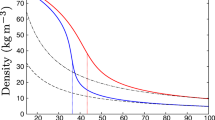Abstract
The one-equation turbulence models by Spalart and Allmaras (SA) and Sekundov et al. (Nut-92) are tested against two compressible two-dimensional flows, namely, the turbulent flat-plate boundary layer at zero pressure gradient and the mixing layer. The boundary layer (BL) approximation is applied to the system of Reynolds equations (RANS). The BL results obtained are compared with the available RANS results and the results of direct numerical simulation (DNS). The modified Nut-92m model proposed predicts the characteristics of the turbulent flat-plate boundary layer at zero pressure gradient more accurately than the Nut-92 and SA models.


Similar content being viewed by others
REFERENCES
D. C. Wilcox, Turbulence Modeling for CFD (DCW Industries, Canada, CA, 2006).
Langley Research Center. NASA Turbulence Modeling Resource. https://turbmodels.larc.nasa.gov/
P. R. Spalart and S. R. Allmaras, “A one-equation turbulence model for aerodynamics flows,” Recherche Aérospatiale No. 1, 5–21 (1994). https://doi.org/10.2514/6.1992-439
A. N. Gulyaev, V. E. Kozlov, and A. N. Sekundov, “A universal one-equation model for turbulent viscosity,” Fluid Dynamics 28(4), 485—494 (1993).
X. Han, M. M. Rahman, and R. K. Agarwal, “Development and application of a wall distance free Wray—Agarwal turbulence model (WA2018),” AIAA Paper No. 0593 (2018). https://doi.org/10.2514/6.2018-0593
P. Bradshaw, B. Launder, and J. Lumley, “Collaborative testing of turbulence models,” AIAA Paper No. 0215 (1991). https://doi.org/10.2514/6.1991-215
M. Shur, M. Strelets, L. Zaikov, A. Gulyaev, V. KozIov, and A. Secundov, “Comparative numerical testing of one- and two-equation turbulence models for flows with separation and reattachement,” AIAA Paper No. 0863 (1995). https://doi.org/10.2514/6.1995-863
C. Zhang, L. Duan, and M. M. Choudhari, “Direct numerical simulation database for supersonic and hypersonic turbulent boundary layers,” AIAA J. 56(11), 4297–4311 (2018). https://doi.org/10.2514/1.J057296
J. Huang, J.-V. Bretzke, and L. Duan, “Assessment of turbulence models in a hypersonic cold-wall turbulent boundary layer,” Fluids 4(37), 10 (2019). https://doi.org/10.3390/fluids4010037
D. Zhang, J. Tan, and X. Yao, “Direct numerical simulation of spatially developing highly compressible mixing layer: Structural evolution and turbulent statistics,” Phys. Fluids 31(3), 036102 (2019). https://doi.org/10.1063/1.5087540
V. R. Kuznetsov, A. B. Lebedev, A. N. Sekundov, and I. P. Smirnova. “Calculation of a turbulent diffusion combustion flame core, taking account of concentration pulsation and Archimedean forces,” Fluid Dynamics 12(1), 24—33 (1977).
V. N. Rasshchupkin and A. N. Sekundov, “Applicability of the boundary-layer approximation to the calculation of a plane turbulent boundary layer,” Fluid Dynamics 11(5), 683—688 (1976).
F. G. Keyes, “A summary of viscosity and heat-conduction data for helium, argon, hydrogen, oxygen, nitrogen, carbon monoxide, carbon dioxide, water and air,” Trans. Am. Mech. Engrs. 73, 589–595 (1951).
N. B. Vargaftik, Handbook on Thermal Properties of Gases and Liquids (Nauka, Moscow 1972) [in Russian].
L. G. Loytsyanskii, Mechanics of Liquids and Gases (Pergamon Press, Oxford, 1966).
P. E. Dimotakis, “Two-dimensional shear-layer entrainment,” AIAA J. 24(11), 1791–1796 (1986). https://doi.org/10.2514/3.9525
S. Fu and Q. B. Li, “Numerical simulation of compressible mixing layers,” Int. J. Heat Fluid Flow 27(5), 895–901 (2006). https://doi.org/10.1016/j.ijheatfluidflow.2006.03.028
C. Pantano and S. Sarkar, “A study of compressibility effects in the high speed turbulent shear layer using direct simulation,” J. Fluid Mech. 451, 329–371 (2002). https://doi.org/10.1017/S0022112001006978
Q. Zhou, F. He, and M. Y. Shen, “Direct numerical simulation of a spatially developing compressible plane mixing layer: Flow structures and mean flow properties,” J. Fluid Mech. 711, 437–468 (2012). https://doi.org/10.1017/jfm.2012.400
J. B. Freund, S. K. Lele, and P. Moin, “Compressibility effects in a turbulent annular mixing layer. Part 1. Turbulence and growth rate,” J. Fluid Mech. 421, 229–267 (2000). https://doi.org/10.1017/S0022112000001622
S. Arun, A. Sameen, and B. Srinivasan, “Structure of vorticity field in compressible turbulent mixing layers,” Physica Scripta 94(9), (2019). https://doi.org/10.1088/1402-4896/ab0aad
Author information
Authors and Affiliations
Corresponding author
Ethics declarations
The Author declares no potential conflicts of interest with respect to the research, authorship, and/or publication of this article.
Additional information
Translated by M. Lebedev
Rights and permissions
About this article
Cite this article
Kozlov, V.E. Compressibility Effectsy in One-Equation Turbulence Models. Fluid Dyn 56, 622–629 (2021). https://doi.org/10.1134/S0015462821050074
Received:
Revised:
Accepted:
Published:
Issue Date:
DOI: https://doi.org/10.1134/S0015462821050074




